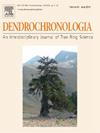Climate change alters the radial growth responses of P. schrenkiana and J. jarkendensis to climate extremes in the Eastern Pamirs
IF 2.7
3区 农林科学
Q1 FORESTRY
引用次数: 0
Abstract
As global temperatures rise, extreme climate events are becoming more intense, frequent, and prolonged, profoundly altering forest ecosystems, particularly in arid and semi-arid regions. This study employs dendrochronological methods to examine the relationship between the radial growth of Picea schrenkiana (P. schrenkiana) and Juniperus jarkendensis (J. jarkendensis) and extreme climate events in the Eastern Pamirs. The findings reveal that: P. schrenkiana is more sensitive to extreme temperatures fluctuations, whereas J. jarkendensis exhibits a stronger response to extreme precipitation. In the context of global warming, P. schrenkiana and J. jarkendensis exhibit a gradual trend of shifting from negative to positive responses to mean temperature (T) and extreme minimum temperature (TNn). Following climatic abruptions, both species display significant positive correlations with T and TNn, reflecting their adaptive adjustments to a warming climate and indicating their ability to leverage more favorable temperature conditions to promote growth. These results suggest that global warming has significantly altered the growth dynamics of these tree species. The interaction of multiple climate factors, rather than a single variable, drives tree growth. Consequently, targeted management and conservation strategies are essential to mitigate the impacts of extreme climate events on different tree species.
气候变化改变了东帕米尔高原雪兰和贾尔肯冬的径向生长对极端气候的响应
随着全球气温上升,极端气候事件变得更加强烈、频繁和持久,深刻地改变了森林生态系统,特别是在干旱和半干旱地区。本文采用树木年代学方法研究了东帕米尔高原云杉(Picea schrenkiana)和刺柏(Juniperus jarkendensis J. jarkendensis)径向生长与极端气候事件的关系。结果表明:P. schrenkiana对极端温度波动更敏感,而J. jarkendensis对极端降水的响应更强。在全球变暖背景下,P. schrenkiana和J. jarkendensis对平均温度(T)和极端最低温度(TNn)的响应呈现由负向正的渐变趋势。在气候突变后,这两个物种都与T和TNn表现出显著的正相关,反映了它们对气候变暖的适应性调整,表明它们有能力利用更有利的温度条件来促进生长。这些结果表明,全球变暖显著改变了这些树种的生长动态。驱动树木生长的是多种气候因素的相互作用,而不是单一的变量。因此,有针对性的管理和保护策略对于减轻极端气候事件对不同树种的影响至关重要。
本文章由计算机程序翻译,如有差异,请以英文原文为准。
求助全文
约1分钟内获得全文
求助全文
来源期刊

Dendrochronologia
FORESTRY-GEOGRAPHY, PHYSICAL
CiteScore
5.50
自引率
13.30%
发文量
82
审稿时长
22.8 weeks
期刊介绍:
Dendrochronologia is a peer-reviewed international scholarly journal that presents high-quality research related to growth rings of woody plants, i.e., trees and shrubs, and the application of tree-ring studies.
The areas covered by the journal include, but are not limited to:
Archaeology
Botany
Climatology
Ecology
Forestry
Geology
Hydrology
Original research articles, reviews, communications, technical notes and personal notes are considered for publication.
 求助内容:
求助内容: 应助结果提醒方式:
应助结果提醒方式:


